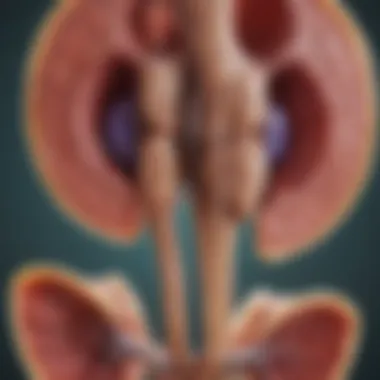Understanding Canine Kidney Failure: Key Insights


Intro
Canine kidney failure isn't just an unfortunate side effect of aging; it’s an urgent health issue that demands attention from pet owners and veterinarians alike. As we navigate through the intricacies of kidney function, it becomes clear that understanding this condition can significantly impact our approach to canine health management. The kidneys play a vital role in filtering waste, conserving fluids, and balancing electrolytes. When these organs falter, the repercussions can ripple through the entire body, affecting a dog's quality of life.
Research Background
Overview of the Scientific Problem Addressed
Kidney failure in dogs is marked by a gradual loss of kidney function, usually diagnosed as acute or chronic. Acute kidney failure can strike unexpectedly, often triggered by factors ranging from toxic ingestion to severe dehydration. On the other hand, chronic kidney disease, a stealthier foe, develops over time, often linked to age, genetics, and underlying health conditions. The challenge lies in identifying the subtle signs that herald the onset of kidney distress, making early intervention paramount.
Historical Context and Previous Studies
Historically, the understanding of kidney diseases in canines has evolved significantly. Earlier research focused primarily on the symptoms presented, but more recent studies have delved into the molecular changes occurring within the kidneys. For instance, analyses have revealed that nephron loss—a functional unit of the kidney—can occur without immediately apparent symptoms. This trend signals a need for proactive monitoring and preventive care, as early detection can lead to more effective management strategies.
Findings and Discussion
Key Results of the Research
Recent studies have illuminated various causes of canine kidney failure, underscoring the role of genetics. Breeds such as Shih Tzus, Persian Cats, and Dachshunds show higher susceptibility to kidney issues. Dietary factors, particularly an imbalance in nutrients or excessive protein intake, can also exacerbate the condition. Environmental elements, such as exposure to toxins like antifreeze or certain plants, compounding these risks, complicate the landscape further.
Interpretation of the Findings
These findings emphasize the importance of a holistic approach to canine health. Regular veterinary check-ups and blood tests can allow for early detection of kidney dysfunction. With the adoption of a keen eye for symptoms such as changes in appetite, increased thirst, or lethargy, pet owners can act swiftly.
"Awareness is the first step in preventing canine kidney issues; educate yourself about the signs and risks relevant to your dog's breed."
In managing this condition, treatments often blend dietary adjustments with medical intervention, offering a spectrum of options tailored to individual needs. Moreover, by fostering a deeper understanding of canine kidney failure, pet owners are better equipped to support their furry friends through this challenging journey.
Foreword to Canine Kidney Failure
Canine kidney failure represents a significant concern for pet owners and veterinary professionals alike. It’s not just another health issue; it’s a serious condition that jeopardizes the life quality of our four-legged friends. As many might know, kidneys play a pivotal role in filtering waste from the blood, managing electrolytes, and regulating blood pressure. When they fail, the consequences can be dire and often lead to a cascade of health complications.
One of the most alarming aspects of kidney failure is that it can be sneaky. Many dogs exhibit no symptoms until the disease has progressed significantly. This makes it crucial for owners to stay informed about the signs of kidney dysfunction. Recognizing early symptoms can potentially lead to early interventions, which may improve prognosis and enhance the dog’s quality of life.
In different ways, this condition can take a toll on both the physical and emotional well-being of the dog, as well as pose a profound emotional challenge for the owner. Witnessing a beloved pet struggle with this debilitating illness can be heart-wrenching. Health decisions often weigh heavily on the minds and hearts of pet parents, and understanding the nuances of kidney failure can lead to more informed choices.
Moreover, education surrounding canine kidney failure can offer insights into possible causes, which can include genetic predispositions, dietary choices, and various environmental factors. Feeding a dog a balanced diet and maintaining a healthy lifestyle might mitigate some of these risks. Understanding these elements not only arms pet owners with knowledge but also emphasizes the importance of preventive care.
In this article, we aim to demystify the complexities surrounding canine kidney failure. By delving into the underlying physiology, symptoms, diagnostic methods, and management strategies, we hope to equip both pet owners and veterinary professionals with the information they need to combat this formidable health concern. In turn, fostering deeper awareness can help ensure our furry companions lead healthier lives, potentially steering their fate in a more positive direction.
"Knowledge is power, especially when it comes to the health of our pets. Understanding kidney failure in dogs ensures we can act swiftly and appropriately."
To encapsulate, embracing a proactive attitude towards canine kidney health is imperative for all dog owners. Knowing when to consult a veterinarian, recognizing warning signs, and being aware of treatment options can make a world of difference. Let's move forward and explore the intricate details of kidney function in dogs, as a solid grasp of these fundamental concepts will set the groundwork for understanding kidney failure more deeply.
Understanding Kidney Function in Dogs
Understanding the function of kidneys in dogs is not just a matter of academic interest; it’s vital for recognizing and managing health issues. Kidneys serve as essential filters for the blood, eliminating toxins while maintaining the necessary balance of electrolytes and fluids. This becomes all the more crucial when focusing on conditions like kidney failure. A keen awareness of how kidneys operate allows pet owners and veterinary professionals to identify problems early, adapt care practices, and ensure a better quality of life for affected dogs.
The Role of Kidneys
The kidneys play several pivotal roles in maintaining canine health. Firstly, they filter the blood to remove waste products such as urea and creatinine. These substances are byproducts of protein metabolism and require careful regulation. When kidneys are functioning properly, they excrete these harmful substances through urine, keeping the blood clean and balanced.
Moreover, kidneys are central to regulating blood pressure. They produce hormones, such as renin, that aid in controlling vascular resistance. This hormonal interaction is crucial for sustaining normal blood pressure levels and ensuring adequate blood flow to vital organs.
Additionally, kidneys maintain electrolyte balance by reabsorbing essential ions like potassium and sodium. By adjusting the amount of these ions excreted in urine, the kidneys help oversee the overall homeostasis of the body.
A pet owner must stay vigilant about any changes in their dog’s health, as kidney dysfunction can often go unnoticed until it becomes significant. Understanding the role of kidneys can empower owners to notice warning signs early, potentially leading to better health outcomes.
Basic Physiology of the Canine Kidneys
The basic physiology of canine kidneys is a realm of intricate processes. Each kidney consists of approximately one million functional units called nephrons, which work tirelessly to maintain the body's equilibrium.
Every nephron has a glomerulus, a cluster of tiny blood vessels where filtration begins, coupled with renal tubules, where reabsorption and secretion of necessary components occur.
Here’s a closer look at how this system works:
- Filtration: It begins in the glomeruli, where waste products and excess substances are filtered from the blood. Only small molecules can pass through while larger molecules like proteins are retained.
- Reabsorption: As the filtrate moves through the renal tubules, essential nutrients and water are reabsorbed back into the bloodstream. This process allows for the conservation of valuable resources and helps manage fluid levels.
- Secretion: Any remaining waste materials that need to be expelled from the body are secreted into the tubules for excretion via urine.
This sophisticated orchestration allows the kidneys not only to filter blood but also to play a proactive role in regulating various bodily functions. Since canine kidneys are so crucial to overall health, understanding these basic physiological functions is essential for all dog owners. Be vigilant; the earlier kidney issues are detected, the more options remain for effective management.
"The kidneys of dogs are like unsung heroes, balancing a myriad of functions that keep our furry companions healthy and thriving."
Pathophysiology of Kidney Failure
Kidney failure in dogs isn’t just a standalone issue; it’s a chain reaction that spirals outward, affecting the dog’s health on multiple levels. Understanding the pathophysiology is crucial, as it helps illuminate the underlying mechanisms that lead to this condition. It lays bare the sequence of physiological breakdown that results in compromised kidney function. This knowledge serves as the backbone of any management plan; if you know what’s going wrong, you’ll understand how to tackle it effectively.
Those who delve into the pathophysiology will come across two main types of kidney failure: acute and chronic. Each type follows a different path across the body’s complex landscape.
Acute vs. Chronic Kidney Failure


Defining Acute Kidney Failure
Acute kidney failure emerges suddenly and can be attributed to various factors, such as trauma or exposure to toxins. The key characteristic here is the abrupt nature of the onset. This immediacy can be a double-edged sword: while it may facilitate quicker diagnosis and intervention, it also poses challenges regarding the severity of damage done within a short period. Acute kidney failure is often connected to specific events, making it a crucial subject for consideration in emergency veterinary care.
A unique feature of acute kidney failure is reversibility. If caught in time, some cases have a better chance of recovery compared to chronic conditions. However, there are disadvantages, such as the need for prompt action and the potential for rapid deterioration if missed.
Understanding Chronic Kidney Disease
Chronic kidney disease, on the other hand, creeps in quietly over time, often unnoticed until significant damage is done. One of its main characteristics is how it develops slowly, frequently due to age or long-term diseases. This gradual onset can be deceptive; while pet owners may think their dog is simply aging, underlying kidney damage may be progressing.
Chronic kidney disease has its unique feature; it usually leads to a progressive decline in kidney function, which can be quite challenging to manage. The long-term nature of this condition requires ongoing treatment and veterinary visits, adding a layer of complexity. However, catching it early can mean better quality of life and slower progression, a silver lining in this grim scenario.
Stages of Kidney Disease
When it comes to kidney disease, identifying where a dog lies on the spectrum is key for proper management.
Identifying Early-Stage Disease
Catching kidney issues early can make all the difference in a dog’s health. The early-stage disease often has subtle symptoms, making it tricky to diagnose without keen observation on the owner's part. The key characteristic of early identification is that it opens the door for proactive treatment strategies, which can help maintain kidney function longer.
A unique feature of recognizing early-stage disease is that it can often be done through routine check-ups. Veterinarians may utilize blood tests and urinalysis to flag potential issues. Early intervention means treatment can often be less intensive and more effective, allowing dogs to maintain a higher quality of life.
Recognizing Advanced Stages
Recognizing when a dog enters an advanced stage of kidney disease is another beast entirely. By this time, clinical signs become much more pronounced, including extreme lethargy, significant weight loss, and frequent vomiting. This phase’s key characteristic is the acute decline in quality of life.
A unique aspect of advanced stages is the need for aggressive treatment strategies. When things reach this point, it often becomes a balancing act between managing symptoms and preparing for end-of-life decisions. For owners, this can be emotionally taxing, but recognizing these signs and understanding what they mean is invaluable in providing compassion and care during a critical time.
In sum, the pathophysiology of kidney failure represents an intricate interplay of causes, stage identification, and management strategies. A well-rounded understanding equips dog owners and veterinary professionals with the essentials to face this detriment head-on.
Causes of Canine Kidney Failure
Canine kidney failure is a complex condition that can arise from various factors, and understanding these causes is paramount for both pet owners and veterinarians. Identifying the underlying reasons for kidney failure in dogs not only assists in preventing the condition but also enables timely interventions. Closely examining the causes can sometimes assist in spotting trends among certain breeds or geographical regions. Moreover, awareness of these factors supports a holistic approach to pet care, encompassing diet, environment, and health monitoring.
Genetic Factors
Certain breeds are predisposed to kidney issues due to genetic inheritance. For example, the Bernese Mountain Dog and Siamese Cat are known for their higher susceptibility to kidney diseases. It’s crucial for breeders to be aware of this tendency and conduct health screenings before breeding. Genetic factors can lead to structural abnormalities in the kidneys or predispose dogs to diseases like polycystic kidney disease (PKD).
Comparative studies highlight that when genes are the culprits, the onset might be gradual and often unnoticed until advanced stages. Knowing a pet’s lineage can inform owners about potential risks, guiding them toward preventive care strategies.
Dietary Influences
The quality and type of a dog’s diet play a significant role in kidney health. Dogs fed high-protein diets over prolonged periods may strain their kidneys. Over time, excessive protein can cause increased waste products in the bloodstream, leading to renal failure.
Notably, diets high in phosphorus can exacerbate existing kidney issues. A balanced diet with appropriate nutrients can greatly reduce the risk of kidney disease. Suggestions often include:
- Choosing high-quality dog food that meets AAFCO standards.
- Ensuring hydration by providing ample fresh water and considering wet food options.
- Consulting with veterinarians regarding appropriate dietary changes based on a dog’s health status.
Environmental Toxins
The environment in which a dog lives can introduce various toxins that may contribute to kidney failure. Common household items, such as certain cleaning products, antifreeze, and even specific plants, can be hazardous. For example, grapes and raisins are well-known for their kidney-damaging effects on dogs, yet many owners may not realize their danger. Environmental influences include:
- Pesticides and herbicides: Dogs that roam untreated yards may ingest harmful chemicals.
- Heavy metals: Lead and mercury contamination can stem from old pipes or certain household items.
- Air quality: Polluted environments may also indirectly affect kidney function through overall health decline.
Awareness and education on these environmental hazards can substantially minimize risk.
Infectious Diseases
Many infectious diseases pose a threat to canine kidney function. A notable example is leptospirosis, a bacterial infection spread through contaminated water and soil. Early symptoms may include fever and lethargy, but if left unchecked, it can lead to severe kidney damage.
Additionally, conditions like urinary tract infections (UTIs) can escalate if they become chronic, leading to renal complications. Dogs at greater risk include those with compromised immune systems or underlying health conditions. Protective measures can be outlined as follows:
- Vaccination: Regular vaccinations can ward off certain infectious diseases.
- Prompt treatment: Any signs of infection should be addressed immediately with veterinary care.
Recognizing these varied causes is vital for a proactive approach towards a dog's health. Through enhanced awareness and education, owners can influence their canine companions’ longevity and quality of life, ultimately being the guardians of their pet's kidney health.
Recognizing Symptoms of Kidney Failure
Recognizing the signs of kidney failure in dogs is vital for timely intervention and better outcomes. Just like the canary in the coal mine, our canine companions display various symptoms that can alert us to potential issues in their kidney function.
Failing to spot the early warning signs may lead to more serious health issues, making it crucial for dog owners to maintain vigilance regarding their pets’ condition. Early detection not only enhances the chances of effective treatment but also contributes significantly to the dog's quality of life. Understanding the core clinical signs can ensure that pets receive the care they need when they need it most.
Common Clinical Signs
Changes in Urination Patterns
Changes in urination patterns are among the first signs to watch for in cases of kidney failure. Normally, a healthy dog maintains a consistent routine when it comes to toilet breaks. However, as the kidneys begin to fail, this can lead to markedly increased urination, known as polyuria. The dog may need to go out more frequently, sometimes even experiencing accidents in the house.
The key characteristic of this symptom is its noticeable shift from typical behavior. Many pet owners find that it’s not just the frequency that changes but also the volume and appearance of the urine itself, sometimes noticing it as being unusually clear.
Why is it a crucial element in this discussion? Because understanding what constitutes a change in urination patterns can prompt owners to seek veterinary help sooner rather than later. A unique feature of monitoring these changes is that they can often happen without other overt signs, making it a silent red flag.


The advantage of identifying this early is that it can lead to swift action, possibly arresting the progression of kidney disease before more damaging effects occur.
Altered Appetite and Weight Loss
Altered appetite and weight loss frequently accompany kidney issues. Dogs might become picky eaters or refuse food entirely, which can lead to significant weight loss over time. This symptom is particularly significant because it highlights the internal struggle; as the kidneys fail to filter waste, toxins build up in the bloodstream, making the dog feel unwell and less inclined to eat.
When we talk about altered appetite, the key characteristic lies in its dual role—it’s both a symptom and a consequence of worsening health. Many owners find weight loss alarming, serving as a wake-up call to the potential health hazards their furry friend is facing.
Unique to this symptom is the combination of weight loss with lethargy and reduced activity levels. Recognizing this combination is beneficial for emphasizing the overall health picture. The drawbacks, however, are that changes in appetite can sometimes be attributed to factors other than kidney failure, causing a delay in addressing potential kidney dysfunction.
Persistent Vomiting
Persistent vomiting can be a distressing sign of kidney failure. This can appear as intermittent episodes or even daily occurrences. The kidneys are crucial for eliminating toxins from the blood, and when they start to fail, these toxins can build up to a level that irritates the stomach, often causing vomiting.
The notable characteristic of persistent vomiting is that it doesn't necessarily respond to typical treatments, making it a strong indicator of underlying issues. It serves as a beneficial focal point for veterinarians as they assess the dog's health. This feature shows that something more serious could be at play, pushing for further diagnostic evaluation.
One advantage of recognizing vomiting as a symptom is its straightforward nature; this is often a glaring issue that leads owners to seek help. However, the corresponding disadvantage is its potential to overlap with other gastrointestinal problems, which can sometimes undermine accurate conclusions about kidney health.
Behavioral Changes
Behavioral changes may manifest as increased aggression, withdrawal, or even confusion. Dogs may seem more anxious or unsure of their surroundings, causing potential misunderstandings about their emotional state.
It’s essential to connect these changes to possible physical ailments, like kidney failure. Understanding the interplay between physical and emotional health can lead to a more comprehensive approach to a dog’s overall care, linking visible discomfort to systemic issues that must be addressed promptly.
Diagnostic Approaches
When faced with the complex issue of canine kidney failure, accurate diagnosis is a pivotal step in the journey of understanding the condition and managing it. Identifying the underlying problems through diagnostic methods is not just about addressing immediate concerns; it's about piecing together a puzzle that can lead to better long-term outcomes for the affected dog. This section discusses various strategies that veterinarians employ to assess kidney health in dogs, focusing on their critical characteristics, benefits, and considerations.
Veterinary Examination
A thorough veterinary examination serves as the first line of defense in diagnosing kidney issues. During this examination, the vet observes the dog's general physical condition, palpates the abdomen, checks for dehydration, and assesses the mucous membranes. Important indicators like abnormal heart rates or abnormal behaviors hint at possible underlying health problems. Upon noticing signs of discomfort, the vet may opt to run additional tests.
A comprehensive examination can often reveal issues that may not be immediately apparent, allowing for early interventions.
Laboratory Tests
Delving deeper, laboratory tests are crucial for confirming suspected kidney issues. This category can be split mainly into two branches: blood tests and urinalysis. Each has its unique advantages, offering different perspectives on a dog’s renal health.
Blood Tests for Kidney Function
Blood tests play a significant role in establishing kidney health. A common test focuses on measuring levels of creatinine and blood urea nitrogen (BUN). These two indicators can reveal how well the kidneys filter waste from the blood. Normally, a dog’s kidneys maintain a delicate balance, and any spike in these levels can signify a malfunction.
- Key characteristic: Blood tests provide immediate results and are less invasive than some imaging techniques.
- Unique feature: They allow for a comprehensive assessment of overall kidney function and systemic health.
- Advantages: Quick results can lead to rapid decision-making regarding treatment; helps in monitoring changes over time.
- Disadvantages: Blood tests alone might not provide detailed information about the kidney structure, necessitating further testing for a complete picture.
Urinalysis Insights
Urinalysis is equally vital in the diagnostic process, shedding light on kidney performance through the analysis of urine samples. This includes checking urine concentration, pH, and the presence of proteins or glucose. Unusual findings can point to underlying issues, such as infections or kidney dysfunction.
- Key characteristic: This test can reveal abnormalities not visible during physical examinations.
- Unique feature: It provides a snapshot of how well the kidneys are filtering waste and handling potential toxins.
- Advantages: Non-invasive and can be performed alongside blood tests; helps assess hydration status and detect infections.
- Disadvantages: Results can be influenced by recent dietary changes or medications, which may complicate interpretation.
Imaging Techniques
When laboratory tests provide inconclusive results or when structural damage to the kidneys is suspected, imaging techniques come into play. These are essential tools for visualizing the kidneys, guiding further diagnosis and treatment options.
Ultrasound Imaging
Ultrasound imaging is a non-invasive method that offers real-time visualization of kidney structures. It can detect abnormalities like tumors, cysts, or changes in kidney size and shape. This technique is beneficial for understanding more than just kidney function; it examines adjacent organs as well.
- Key characteristic: It gives a dynamic view of kidney function and surrounding tissues.
- Unique feature: Provides detailed images without exposing the dog to radiation.
- Advantages: Safe, quick, and provides valuable insights that blood and urinalysis may miss.
- Disadvantages: Requires a skilled operator to interpret results accurately, and is usually more expensive.
X-ray Evaluations
X-rays can also play a role in assessing kidney health, particularly when trying to identify stones or other obstructions in the urinary tract. While not specifically focused on kidney function, they provide important information on the overall structure.
- Key characteristic: X-rays are great for quickly identifying physical blockages.
- Unique feature: They can visualize the size and position of the kidneys and urinary tract.
- Advantages: Fast and widely available; can be performed without sedation in many cases.
- Disadvantages: Limited in function assessment compared to ultrasound or blood tests; exposes the dog to radiation.
Management and Treatment Options
Managing canine kidney failure requires a multi-faceted approach that seeks not only to halt the progression of the disease but also to enhance the quality of life for the affected pup. Owners play a crucial role in monitoring their dog's condition, ensuring adherence to treatment plans, and maintaining open communication with their veterinarian. Every treatment method, whether dietary, medicinal, or supportive, involves thoughtful consideration tailored to each dog’s unique health circumstances, age, and stage of kidney disease.
Dietary Management
Formulating a Renal Diet
A renal diet is specifically designed to support a dog’s declining kidney function while managing symptoms of kidney failure. The cornerstone of a renal diet typically includes lower protein levels. This helps to decrease the workload on the kidneys, which are already struggling to filter waste from the blood. Additionally, a proper renal diet may also limit phosphorus, which, if accumulated, can lead to further damaging effects.
The key characteristic of a renal diet is its balance of high-quality protein and restricted minerals. Unlike standard diets, which may be heavy in by-products and fillers, renal diets focus on easily digestible proteins, high-quality carbohydrates, and essential fatty acids. This approach is increasingly recognized within this article and by many veterinarians as a beneficial method for reducing the progression of kidney disease.
A unique feature of renal diets is that they often incorporate omega-3 fatty acids, which can help reduce inflammation and potentially protect against the loss of kidney function. However, challenges can arise, such as a dog’s refusal to eat these specialized meals, sometimes due to their distinct taste or texture.
Hydration and Electrolyte Balance


Hydration is critical for dogs suffering from kidney failure, as it directly influences their overall well-being. Proper hydration helps flush toxins out of the body and keeps blood flowing efficiently to the kidneys. Ensuring your dog consumes adequate fluids can greatly assist in alleviating some symptoms of kidney failure.
A key characteristic in maintaining hydration and electrolyte balance is the use of wet food rather than dry kibble. Wet food contains a higher water content, which can help provide the necessary hydration alongside nutritional support. In terms of this article, promoting fluid intake is consistent with recommended management protocols.
The unique aspect to consider is the careful monitoring of electrolytes, especially sodium and potassium levels, as imbalances can occur in dogs with renal failure. Too much sodium can lead to further complications, whereas low potassium levels can cause muscle weakness and other health issues. Thus, checking electrolytes regularly is important, and adjustments must be made based on veterinary guidance.
Medication and Supplements
Phosphorus Binders
Phosphorus binders are medications introduced into the management of canine kidney failure that help to control hyperphosphatemia, a common condition where phosphorus levels rise due to compromised kidney function. The high levels of phosphorus can cause further damage to the kidneys and lead to additional health complications if not carefully managed.
These medications work by binding the phosphorus within the food so it can’t be absorbed into the bloodstream, promoting healthier phosphate levels, which is pivotal for dogs diagnosed with kidney disease. Their strength lies in their ability to minimize the absorption of phosphorus, thus slowing the progression of kidney failure.
However, relying exclusively on phosphorus binders may not fully address dietary phosphorus consumed; it is essential to implement appropriate dietary restrictions to complement their use.
Antihypertensive Agents
Antihypertensive agents are prescribed for dogs suffering from hypertension associated with chronic kidney disease. High blood pressure can complicate the condition, leading to further damage to other vital organs. These medications primarily work by relaxing blood vessels, improving blood flow, and ultimately reducing the heart's workload.
A critical aspect of using antihypertensive agents is enhancing overall cardiovascular health, which plays a vital role in managing kidney conditions over time. As part of this article, they are presented as a pivotal line of defense in maintaining canine health amidst kidney failure.
Unique to antihypertensive treatments is the need for consistent monitoring to prevent overly low blood pressure, which can result from an imbalance in managing these medications. Awareness of the dog’s overall health is imperative when integrating these agents into their treatment plan.
Supportive Care Strategies
Supportive care is centered around nurturing a dog’s overall well-being as it navigates the challenges posed by kidney failure. This may involve a combination of regular vet visits, pain management, and behavioral changes to accommodate the dog's declining health. Keeping stress to a minimum and ensuring a calm environment can significantly contribute to a dog's comfort and happiness as they cope with this serious condition. Plus, engaging in activities that are gentle helps keep them stimulated without overwhelming them.
Prognosis and Quality of Life
Understanding the prognosis for dogs with kidney failure is a cornerstone in managing their health and ensuring an optimal quality of life. Prognosis isn’t just about the expected outcome; it encapsulates how well a dog can live day-to-day while coping with a chronic condition. Every dog is unique, and the outcomes can vary significantly based on a multitude of factors including age, stage of the disease, and underlying health conditions. The overarching goal is to provide a framework for owners to navigate the complexities of this health issue, allowing them to make informed decisions regarding their pet's care.
Understanding Prognosis Factors
Several factors contribute to the prognosis of canine kidney failure. These include:
- Age and Breed: Young, otherwise healthy dogs may bounce back better than older ones. Certain breeds, like the Doberman Pinscher, are genetically predisposed to kidney issues, affecting their prognosis.
- Stage of Kidney Disease: The earlier the disease is detected and treated, the better the prognosis. Early intervention can significantly prolong both lifespan and quality of life.
- Underlying Health Conditions: If a dog has existing health problems, these can complicate recovery and overall health, making prognosis more nuanced.
- Owner Engagement: The degree to which owners can follow dietary guidelines, medications, and treatment plans plays a role. Active participation can lead to better outcomes.
"A proactive approach in managing your dog's care can lead to better quality of life even in the face of adversity."
Impact on Dog's Life Stages
Kidney failure doesn’t impact dogs uniformly; the consequences and management strategies can differ widely based on their life stage:
- Puppy Stage: Young dogs typically have robust resilience, but their smaller size and developing bodies can complicate management and treatment strategies. Special attention to nutrition and hydration can make a world of difference.
- Adolescent/Adult Stage: During this stage, dogs are more physically active, and owners should focus on maintaining a healthy lifestyle. Regular check-ups can help in early detection of kidney issues.
- Senior Stage: Older dogs often face a multitude of health challenges simultaneously. Managing kidney failure often involves complex medication and dietary controls. Comfort becomes paramount at this life stage, and focusing on quality rather than quantity of life is essential.
By understanding these factors, pet owners can cultivate a supportive environment that enhances their dog’s quality of life, irrespective of the challenges posed by kidney failure. The emotional bonds between canines and their owners are unique, and nurturing that relationship during difficult times can be rewarding for both. This knowledge equips owners to face uncertainties, helping them to create fulfilling lives for their dogs, despite the challenges ahead.
Preventive Measures
Preventive measures in canine kidney failure are vital both for awareness and action. Just like humans, dogs benefit greatly from early intervention. Preventing kidney failure is more than just luck; it involves consistent effort and a proactive attitude toward a dog’s health. Understanding the importance of routine check-ups and vigilant monitoring can make a world of difference.
Regular Veterinary Check-ups
Regular veterinary check-ups are the cornerstone of preventive care. These visits allow for early detection of any kidney issues before they spiral into something more severe. Vets often test for kidney function through blood and urine tests, which can unveil problems undetectable by simple observation.
- Early Detection: Catching potential issues early often leads to better outcomes. Just a simple blood test can shine a light on your dog’s kidney function, which might be the difference between life and death in some unfortunate cases.
- Tailored Advice: Every dog is unique. A vet can personalize care recommendations based on a dog’s age, breed, and preexisting conditions. For instance, a Labrador retriever might have different dietary needs compared to a Dachshund.
- Vaccination Checks: Some vaccines contain components that could stress the kidneys. During check-ups, vets can advise about health risks related to vaccinations, ensuring that dogs are safeguarded appropriately without overstressing their renal function.
- Diet Consultation: Regular visits give dog owners a chance to discuss dietary needs, which is crucial since diet plays a significant role in kidney health. The vet might suggest specific foods low in phosphorus and protein to help sustain kidney function.
Veterinary check-ups should be scheduled at least once a year for healthy dogs and more frequently for those with existing health problems or advancing age.
Health Monitoring and Owner Responsibilities
Health monitoring is not solely the vet's job; owners have crucial responsibilities that can impact their dog's kidney health drastically. Understanding how to observe changes in your dog's behavior can be essential.
- Observe Water Intake: Dogs will naturally drink more or less depending on activity and weather, but a sudden spike in thirst can be alarming. Increased thirst, or polydipsia, can indicate kidney issues.
- Note Bathroom Habits: Changes in urination patterns, such as frequent or infrequent urination, can signal kidney complications. Whether your dog starts having accidents indoors or spends too long outside can speak volumes about their kidney status.
- Monitor Dietary Changes: Keep an eye on their food consumption. If a usually ravenous eater suddenly turns their nose up at dinner, that's a red flag. Weight loss or gain can also hint at underlying health issues.
- Behavioral Observations: Any noticeable shifts in energy levels—be it lethargy or hyperactivity—should not be overlooked. Dogs often mask discomfort, so changes in routine can be telling.
In essence, a proactive approach to health and implementing preventive measures can significantly reduce the risk of developing kidney failure in dogs. The goal is to keep those tails wagging and help your furry companions lead long, healthy lives. Remember, an ounce of prevention truly is worth a pound of cure.
"Preventive care is not just about avoiding sickness; it’s a commitment to fostering a state of well-being, allowing dogs to thrive healthily."
Keeping up with regular veterinary visits and staying attentive to your dog’s behaviors can make all the difference in their kidney health.
Finale
In summarizing the journey through canine kidney failure, it’s imperative to recognize its profound effects on dogs. This condition isn't just a clinical diagnosis; it represents a significant disruption to a dog's quality of life and alters the dynamic between pets and their owners. The implications extend beyond physical well-being, touching on emotional and social aspects of pet ownership.
The importance of early recognition and intervention cannot be overstated. Pet owners must be vigilant, understanding the symptoms that may indicate kidney issues. An early diagnosis can be a game-changer, permitting more effective management strategies to be implemented before the condition escalates into more severe stages.
Key elements from this exploration include:
- The necessity of regular veterinary check-ups; a stitch in time saves nine.
- The role of dietary choices; what goes into their bowl affects their health directly.
- The influence of environmental factors; being aware of toxins can prevent many problems.
- Owner education as vital; informed owners are empowered to take the right actions.
Moreover, understanding the broader context of how chronic conditions can affect canines at various life stages adds another layer to effective management. Seniors may exhibit different needs compared to a younger dog diagnosed with kidney problems.
In essence, managing canine kidney failure isn't solely about medical interventions. It involves a holistic approach encompassing veterinary care, dietary adjustments, environmental management, and a commitment to ongoing education. This comprehensive strategy assures that dogs can enjoy a better quality of life, even in the face of such challenges. By fostering a partnership between veterinary services and committed pet owners, we can significantly enhance the future health prospects for dogs facing kidney failure.
"Education breeds confidence, confidence breeds hope, and hope breeds peace."







